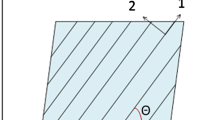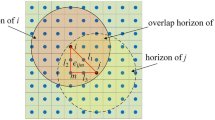Abstract
An improved ordinary state-based peridynamic model for fiber-reinforced composite laminate was proposed and applied to fracture analysis in laminated plates with different configurations. The mechanical properties of composite materials are realized by bonds whose orientations lie along the principal axes. The new model works for general fiber orientations with respect to a uniform discretization grid, which is an extension of the state-based peridynamic laminate theory proposed by Madenci and Oterkus. Using the revised model, quantitative quasi-static simulations of laminates under uniaxial tensile loading and compact tensile tests are conducted to validate the elasticity and fracture behavior of laminated materials. The displacement fields and crack propagation are calculated and compared with existing numerical data. The enhanced model is able to represent the fracture characteristics and displacement fields of composite laminates with general fiber orientations, according to the results.






















Similar content being viewed by others
References
Camanho P, Lambert M (2006) A design methodology for mechanically fastened joints in laminated composite materials. Compos Sci and Technol 66:3004–3020
Zhang Y, Qiao P (2021) A fully-discrete peridynamic modeling approach for tensile fracture of fiber-reinforced cementitious composites. Eng Fract Mech 242:107454
Cao X, Qin X, Li H, Shang S, Li S, Liu H (2022) Non-ordinary state-based peridynamic fatigue modelling of composite laminates with arbitrary fibre orientation. Theor Appl Fract Mec 120:103393
Li S, Thouless M, Waas A, Schroeder J, Zavattieri P (2005) Use of a cohesive-zone model to analyze the fracture of a fiber-reinforced polymer-matrix composite. Compos Sci and Technol 65:537–549
Hou Y, Tie Y, Li C, Meng L, Sapanathan T, Rachik M (2019) On the damage mechanism of high-speed ballast impact and compression after impact for CFRP laminates. Compos Struct 229:111435
Tie Y, Hou Y, Li C, Zhou X, Sapanathan T, Rachik M (2018) An insight into the low-velocity impact behavior of patch-repaired CFRP laminates using numerical and experimental approaches. Compos Struct 190:179–188
Zhou W, Liu D, Liu N (2017) Analyzing dynamic fracture process in fiber-reinforced composite materials with a peridynamic model. Eng Fract Mech 178:60–76
Silling S (2000) Reformulation of elasticity theory for discontinuities and long-range forces. J Mech Phy Solids 48:175–209
Silling S, Askari E (2005) A meshfree method based on the peridynamic model of solid mechanics. Compos Struct 83:1526–1535
Silling S, Barr C, Cooper M (2021) Inelastic peridynamic model for molecular crystal particles. Comput Part Mech 8:1005–1017
Madenci E, Oterkus E (2014) Peridynamic Theory and its Applications, vol 5. Springer, New York
Zhang T, Zhou X (2019) A modified axisymmetric ordinary state-based peridynamics with shear deformation for elastic and fracture problems in brittle solids. Eur J Mech A-Solid 77:103810
Kilic B, Madenci E (2010) An adaptive dynamic relaxation method for quasi-static simulations using the peridynamic theory. Theor Appl Fract Mec 53:194–204
Breitenfeld M, Geubelle P, Weckner O, Silling S (2014) Non-ordinary state-based peridynamic analysis of stationary crack problems. Comput Method Appl M 272:233–250
Chen Z, Jafarzadeh S, Zhao J, Bobaru F (2021) A coupled mechano-chemical peridynamic model for pit-to-crack transition in stress-corrosion cracking. J Mech Phys Solids 146:104203
Xu J, Askari A, Weckner O, Silling S (2008) Peridynamic analysis of impact damage in composite laminates. J Aerospace Eng 21:187–194
Hu W, Ha Y, Bobaru F (2012) Peridynamic model for dynamic fracture in unidirectional fiber-reinforced composites. Comput Method Appl M 217–220:247–261
Kilic B, Agwai A, Madenci E (2009) Peridynamic theory for progressive damage prediction in center-cracked composite laminates. Compos Struct 90:141–151
Oterkus E, Madenci E (2015) Peridynamic analysis of fiber-reinforced composite materials. J Mech Mater Struct 7:45–84
Askari A, Azdoud Y, Han F, Lubineau G, Silling S (2015) Peridynamics for analysis of failure in advanced composite materials. Numerical Modelling of Failure in Advanced Composite Materials. Woodhead Publishing, USA
Hu Y, Madenci E (2017) Peridynamics for fatigue life and residual strength prediction of composite laminates. Compos Struct 160:169–184
Hattori G, Trevelyan J, Coombs W (2018) A non-ordinary state-based peridynamics framework for anisotropic materials. Comput Method Appl M 339:416–442
Silling S, Epton M, Weckner O (2007) Peridynamic States and Constitutive Modeling. J Elasticity 88:151–184
Silling S (2010) Linearized theory of peridynamic states. J Elasticity 99:85–111
Sarego G, Le Q, Bobaru F, Zaccariotto M (2016) Linearized State-based Peridynamics for 2D Problems. Int J Numer Meth Eng 108:1174–1197
Warren T, Silling S, Askari A, Weckner O, Epton M, Xu J (2009) A non-ordinary state-based peridynamic method to model solid material deformation and fracture. Int J Solids Struct 46:1186–1195
Zhou X, Tian D (2021) A novel linear elastic constitutive model for continuum-kinematics-inspired peridynamics. Comput Method Appl M 373:113479
Ghajari M, Iannucci L, Curtis P (2014) A peridynamic material model for the analysis of dynamic crack propagation in orthotropic media. Comput Method Appl M 276:431–452
Hu Y, Yu Y, Wang H (2014) Peridynamic analytical method for progressive damage in notched composite laminates. Compos Struct 108:801–810
Hu Y, Yu Y, Madenci E (2020) Peridynamic modeling of composite laminates with material coupling and transverse shear deformation. Compos Struct 253:112760
Fang G, Liu S, Liang J, Fu M, Wang B, Meng S (2021) A stable non-ordinary state-based peridynamic model for laminated composite materials. Int J Numer Meth Eng 122:403–430
Shang S, Qin X, Li H, Cao X (2019) An application of non-ordinary state-based peridynamics theory in cutting process modelling of unidirectional carbon fiber reinforced polymer material. Compos Struct 226:111194
Diana V, Ballarini R (2020) Crack kinking in isotropic and orthotropic micropolar peridynamic solids. Int J Solids Struct 196–197:76–98
Tian D, Zhou X (2021) A continuum-kinematics-inspired peridynamic model of anisotropic continua: elasticity, damage, and fracture. Int J Mech Sci 199:106413
Diyaroglu C, Oterkus E, Madenci E, Rabczuk T, Siddiq A (2016) Peridynamic modeling of composite laminates under explosive loading. Compos Struct 144:14–23
Oterkus E, Oterkus S, Madenci E (2021) Peridynamic modeling of compression after impact damage in composite Laminates. J Peridynamics Nonlocal Model 3:327–347
Oterkus E, Oterkus S, Madenci E (2021) Peridynamic modeling, numerical techniques, and applications, vol 14. Springer, New York
Zhang H, Qiao P (2019) A state-based peridynamic model for quantitative elastic and fracture analysis of orthotropic materials. Eng Fract Mech 206:147–171
Colavito K, Barut A, Madenci E, Phan N (2013) Residual strength of composite laminates with a hole by using peridynamic theory. 54th AIAA/ASME/ASCE/AHS/ASC structures, structural dynamics, and materials conference
Hu Y, Carvalho N, Madenci E (2015) Peridynamic modeling of delamination growth in composite laminates. Compos Struct 132:610–620
Jiang X, Wang H (2018) Ordinary state-based peridynamics for open-hole tensile strength prediction of fiber-reinforced composite laminates. J Mech Mater Struct 13:53–82
Hu Y, Madenci E (2016) Bond-based peridynamic modeling of composite laminates with arbitrary fiber orientation and stacking sequence. Compos Struct 153:139–175
ASTM -12e3 (2013) Standard test method for linear elastic plane strain fracture toughness KIC of metallic material
Behiri J, Bonfield W (1989) Orientation dependence of the fracture mechanics of cortical bone. J Biomech 22:863–872
Bogert P, Satyanarayana A, Chunchu P (2006) Comparison of damage path predictions for composite laminates by explicit and standard finite element analysis tools, vol 3 AIAA/ASME/ASCE/AHS/ASC structures, structural dynamics and materials conference
Le Q, Bobaru F (2018) Surface corrections for peridynamic models in elasticity and fracture. Comput Mech 61:499–518
Acknowledgements
The research work was supported by the National Natural Science Foundations of China (No. U1833116 and 11402234 and 52175153).
Author information
Authors and Affiliations
Corresponding author
Ethics declarations
Conflict of interest
The authors declare that they have no known competing financial interests or personal relationships that could have appeared to influence the work reported in this paper.
Additional information
Publisher's Note
Springer Nature remains neutral with regard to jurisdictional claims in published maps and institutional affiliations.
Rights and permissions
Springer Nature or its licensor (e.g. a society or other partner) holds exclusive rights to this article under a publishing agreement with the author(s) or other rightsholder(s); author self-archiving of the accepted manuscript version of this article is solely governed by the terms of such publishing agreement and applicable law.
About this article
Cite this article
Qi, J., Li, C., Tie, Y. et al. An ordinary state-based peridynamic computational investigation of fiber-reinforced composites. Comp. Part. Mech. 10, 777–791 (2023). https://doi.org/10.1007/s40571-022-00525-2
Received:
Revised:
Accepted:
Published:
Issue Date:
DOI: https://doi.org/10.1007/s40571-022-00525-2




